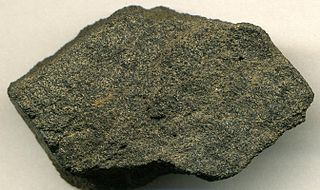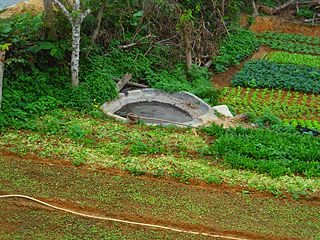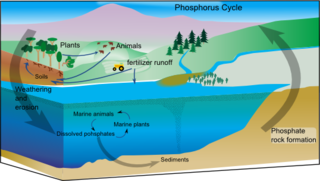
In chemistry, a phosphate is an anion, salt, functional group or ester derived from a phosphoric acid. It most commonly means orthophosphate, a derivative of orthophosphoric acid, aka. phosphoric acid H3PO4.

A fertilizer or fertiliser is any material of natural or synthetic origin that is applied to soil or to plant tissues to supply plant nutrients. Fertilizers may be distinct from liming materials or other non-nutrient soil amendments. Many sources of fertilizer exist, both natural and industrially produced. For most modern agricultural practices, fertilization focuses on three main macro nutrients: nitrogen (N), phosphorus (P), and potassium (K) with occasional addition of supplements like rock flour for micronutrients. Farmers apply these fertilizers in a variety of ways: through dry or pelletized or liquid application processes, using large agricultural equipment or hand-tool methods.

In agriculture, a green manure is a crop specifically cultivated to be incorporated into the soil while still green. Typically, the green manure's biomass is incorporated with a plow or disk, as is often done with (brown) manure. The primary goal is to add organic matter to the soil for its benefits. Green manuring is often used with legume crops to add nitrogen to the soil for following crops, especially in organic farming, but is also used in conventional farming.

Plant nutrition is the study of the chemical elements and compounds necessary for plant growth and reproduction, plant metabolism and their external supply. In its absence the plant is unable to complete a normal life cycle, or that the element is part of some essential plant constituent or metabolite. This is in accordance with Justus von Liebig’s law of the minimum. The total essential plant nutrients include seventeen different elements: carbon, oxygen and hydrogen which are absorbed from the air, whereas other nutrients including nitrogen are typically obtained from the soil.
The pedosphere is the outermost layer of the Earth that is composed of soil and subject to soil formation processes. It exists at the interface of the lithosphere, atmosphere, hydrosphere and biosphere. The pedosphere is the skin of the Earth and only develops when there is a dynamic interaction between the atmosphere, biosphere, lithosphere and the hydrosphere. The pedosphere is the foundation of terrestrial life on Earth.

Phosphorite, phosphate rock or rock phosphate is a non-detrital sedimentary rock that contains high amounts of phosphate minerals. The phosphate content of phosphorite (or grade of phosphate rock) varies greatly, from 4% to 20% phosphorus pentoxide (P2O5). Marketed phosphate rock is enriched ("beneficiated") to at least 28%, often more than 30% P2O5. This occurs through washing, screening, de-liming, magnetic separation or flotation. By comparison, the average phosphorus content of sedimentary rocks is less than 0.2%. The phosphate is present as fluorapatite Ca5(PO4)3F typically in cryptocrystalline masses (grain sizes < 1 μm) referred to as collophane-sedimentary apatite deposits of uncertain origin. It is also present as hydroxyapatite Ca5(PO4)3OH or Ca10(PO4)6(OH)2, which is often dissolved from vertebrate bones and teeth, whereas fluorapatite can originate from hydrothermal veins. Other sources also include chemically dissolved phosphate minerals from igneous and metamorphic rocks. Phosphorite deposits often occur in extensive layers, which cumulatively cover tens of thousands of square kilometres of the Earth's crust.

Soil fertility refers to the ability of soil to sustain agricultural plant growth, i.e. to provide plant habitat and result in sustained and consistent yields of high quality. It also refers to the soil's ability to supply plant/crop nutrients in the right quantities and qualities over a sustained period of time. A fertile soil has the following properties:

Diammonium phosphate (DAP; IUPAC name diammonium hydrogen phosphate; chemical formula (NH4)2(HPO4) is one of a series of water-soluble ammonium phosphate salts that can be produced when ammonia reacts with phosphoric acid.

Organic fertilizers are fertilizers that are naturally produced. Fertilizers are materials that can be added to soil or plants, in order to provide nutrients and sustain growth. Typical organic fertilizers include all animal waste including meat processing waste, manure, slurry, and guano; plus plant based fertilizers such as compost; and biosolids. Inorganic "organic fertilizers" include minerals and ash. The organic-mess refers to the Principles of Organic Agriculture, which determines whether a fertilizer can be used for commercial organic agriculture, not whether the fertilizer consists of organic compounds.
Agrogeology is the study of the origins of minerals known as agrominerals and their applications. These minerals are of importance to farming and horticulture, especially with regard to soil fertility and fertilizer components. These minerals are usually essential plant nutrients. Agrogeology can also be defined as the application of geology to problems in agriculture, particularly in reference to soil productivity and health. This field is a combination of a few different fields, including geology, soil science, agronomy, and chemistry. The overall objective is to advance agricultural production by using geological resources to improve chemical and physical aspects of soil.

Agrominerals are minerals of importance to agriculture and horticulture industries for they can provide essential plant nutrients. Some agrominerals occur naturally or can be processed to be used as alternative fertilizers or soil amendments. The term agromineral was created in the 19th century and is now one of the leading research topics for sustainable agriculture. These geomaterials are used to replenish the nutrients and amend soils. Agrominerals started with small uses most often seen in hobbyist gardening but are moving to a much larger scale such as commercial farming operations that take up 100's acres of land. In this transition the focus changed to be more on ground nutrients, mainly on the three major plant nutrients nitrogen (N), phosphorus (P), and potassium (K). Two of the three elements are only being harvested from a geomaterial called potash. Alternative sources are being researched, due to potash finite supply and cost.
Soil acidification is the buildup of hydrogen cations, which reduces the soil pH. Chemically, this happens when a proton donor gets added to the soil. The donor can be an acid, such as nitric acid, sulfuric acid, or carbonic acid. It can also be a compound such as aluminium sulfate, which reacts in the soil to release protons. Acidification also occurs when base cations such as calcium, magnesium, potassium and sodium are leached from the soil.

The phosphorus cycle is the biogeochemical cycle that describes the movement of phosphorus through the lithosphere, hydrosphere, and biosphere. Unlike many other biogeochemical cycles, the atmosphere does not play a significant role in the movement of phosphorus, because phosphorus and phosphorus-based compounds are usually solids at the typical ranges of temperature and pressure found on Earth. The production of phosphine gas occurs in only specialized, local conditions. Therefore, the phosphorus cycle should be viewed from whole Earth system and then specifically focused on the cycle in terrestrial and aquatic systems.

In agriculture, leaching is the loss of water-soluble plant nutrients from the soil, due to rain and irrigation. Soil structure, crop planting, type and application rates of fertilizers, and other factors are taken into account to avoid excessive nutrient loss. Leaching may also refer to the practice of applying a small amount of excess irrigation where the water has a high salt content to avoid salts from building up in the soil. Where this is practiced, drainage must also usually be employed, to carry away the excess water.

Agricultural pollution refers to biotic and abiotic byproducts of farming practices that result in contamination or degradation of the environment and surrounding ecosystems, and/or cause injury to humans and their economic interests. The pollution may come from a variety of sources, ranging from point source water pollution to more diffuse, landscape-level causes, also known as non-point source pollution and air pollution. Once in the environment these pollutants can have both direct effects in surrounding ecosystems, i.e. killing local wildlife or contaminating drinking water, and downstream effects such as dead zones caused by agricultural runoff is concentrated in large water bodies.

A biofertilizer is a substance which contains living micro-organisms which, when applied to seeds, plant surfaces, or soil, colonize the rhizosphere or the interior of the plant and promotes growth by increasing the supply or availability of primary nutrients to the host plant. Biofertilizers add nutrients through the natural processes of nitrogen fixation, solubilizing phosphorus, and stimulating plant growth through the synthesis of growth-promoting substances. The micro-organisms in biofertilizers restore the soil's natural nutrient cycle and build soil organic matter. Through the use of biofertilizers, healthy plants can be grown, while enhancing the sustainability and the health of the soil. Biofertilizers can be expected to reduce the use of synthetic fertilizers and pesticides, but they are not yet able to replace their use. Since they play several roles, a preferred scientific term for such beneficial bacteria is "plant-growth promoting rhizobacteria" (PGPR).

The history of fertilizer has largely shaped political, economic, and social circumstances in their traditional uses. Subsequently, there has been a radical reshaping of environmental conditions following the development of chemically synthesized fertilizers.

Manure is organic matter that is used as organic fertilizer in agriculture. Most manure consists of animal feces; other sources include compost and green manure. Manures contribute to the fertility of soil by adding organic matter and nutrients, such as nitrogen, that are utilised by bacteria, fungi and other organisms in the soil. Higher organisms then feed on the fungi and bacteria in a chain of life that comprises the soil food web.

Phosphate solubilizing bacteria (PSB) are beneficial bacteria capable of solubilizing inorganic phosphorus from insoluble compounds. P-solubilization ability of rhizosphere microorganisms is considered to be one of the most important traits associated with plant phosphate nutrition. It is generally accepted that the mechanism of mineral phosphate solubilization by PSB strains is associated with the release of low molecular weight organic acids, through which their hydroxyl and carboxyl groups chelate the cations [an ion that have positive charge on it.] bound to phosphate, thereby converting it into soluble forms. PSB have been introduced to the Agricultural community as phosphate Biofertilizer. Phosphorus (P) is one of the major essential macronutrients for plants and is applied to soil in the form of phosphate fertilizers. However, a large portion of soluble inorganic phosphate which is applied to the soil as chemical fertilizer is immobilized rapidly and becomes unavailable to plants. Currently, the main purpose in managing soil phosphorus is to optimize crop production and minimize P loss from soils. PSB have attracted the attention of agriculturists as soil inoculums to improve the plant growth and yield. When PSB is used with rock phosphate, it can save about 50% of the crop requirement of phosphatic fertilizer. The use of PSB as inoculants increases P uptake by plants. Simple inoculation of seeds with PSB gives crop yield responses equivalent to 30 kg P2O5 /ha or 50 percent of the need for phosphatic fertilizers. Alternatively, PSB can be applied through fertigation or in hydroponic operations. Many different strains of these bacteria have been identified as PSB, including Pantoea agglomerans (P5), Microbacterium laevaniformans (P7) and Pseudomonas putida (P13) strains are highly efficient insoluble phosphate solubilizers. Recently, researchers at Colorado State University demonstrated that a consortium of four bacteria, synergistically solubilize phosphorus at a much faster rate than any single strain alone. Mahamuni and Patil (2012) isolated four strains of phosphate solubilizing bacteria from sugarcane (VIMP01 and VIMP02) and sugar beet rhizosphere (VIMP03 and VIMP 04). Isolates were strains of Burkholderia named as VIMP01, VIMP02, VIMP03 and VIMP04. VIMP (Vasantdada Sugar Institute Isolate by Mahamuni and Patil) cultures were identified as Burkholderia cenocepacia strain VIMP01 (JQ867371), Burkholderia gladioli strain VIMP02 (JQ811557), Burkholderia gladioli strain VIMP03 (JQ867372) and Burkholderia species strain VIMP04 (JQ867373)6].
Seventeen elements or nutrients are essential for plant growth and reproduction. They are carbon (C), hydrogen (H), oxygen (O), nitrogen (N), phosphorus (P), potassium (K), sulfur (S), calcium (Ca), magnesium (Mg), iron (Fe), boron (B), manganese (Mn), copper (Cu), zinc (Zn), molybdenum (Mo), nickel (Ni) and chlorine (Cl). Nutrients required for plants to complete their life cycle are considered essential nutrients. Nutrients that enhance the growth of plants but are not necessary to complete the plant's life cycle are considered non-essential. With the exception of carbon, hydrogen and oxygen, which are supplied by carbon dioxide and water, and nitrogen, provided through nitrogen fixation, the nutrients derive originally from the mineral component of the soil. The Law of the Minimum expresses that when the available form of a nutrient is not in enough proportion in the soil solution, then other nutrients cannot be taken up at an optimum rate by a plant. A particular nutrient ratio of the soil solution is thus mandatory for optimizing plant growth, a value which might differ from nutrient ratios calculated from plant composition.















